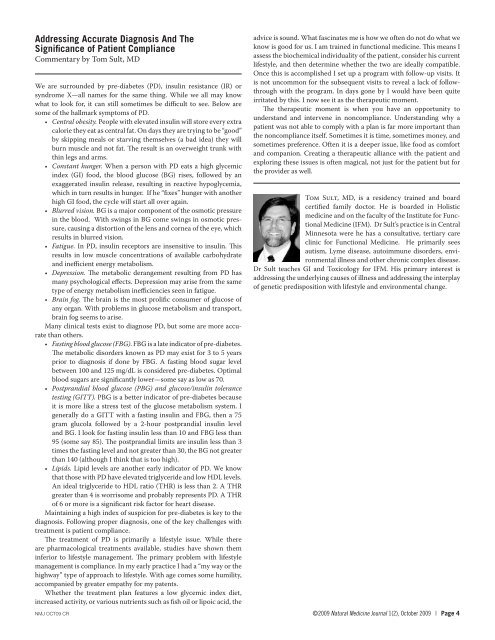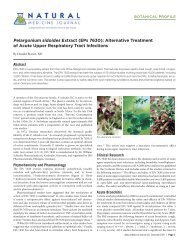Diagnosis and Possible Reversal of Pre-Diabetes: - Natural ...
Diagnosis and Possible Reversal of Pre-Diabetes: - Natural ...
Diagnosis and Possible Reversal of Pre-Diabetes: - Natural ...
You also want an ePaper? Increase the reach of your titles
YUMPU automatically turns print PDFs into web optimized ePapers that Google loves.
Addressing Accurate <strong>Diagnosis</strong> And The<br />
Significance <strong>of</strong> Patient Compliance<br />
Commentary by Tom Sult, MD<br />
We are surrounded by pre-diabetes (PD), insulin resistance (IR) or<br />
syndrome X—all names for the same thing. While we all may know<br />
what to look for, it can still sometimes be difficult to see. Below are<br />
some <strong>of</strong> the hallmark symptoms <strong>of</strong> PD.<br />
• Central obesity. People with elevated insulin will store every extra<br />
calorie they eat as central fat. On days they are trying to be “good”<br />
by skipping meals or starving themselves (a bad idea) they will<br />
burn muscle <strong>and</strong> not fat. The result is an overweight trunk with<br />
thin legs <strong>and</strong> arms.<br />
• Constant hunger. When a person with PD eats a high glycemic<br />
index (GI) food, the blood glucose (BG) rises, followed by an<br />
exaggerated insulin release, resulting in reactive hypoglycemia,<br />
which in turn results in hunger. If he “fixes” hunger with another<br />
high GI food, the cycle will start all over again.<br />
• Blurred vision. BG is a major component <strong>of</strong> the osmotic pressure<br />
in the blood. With swings in BG come swings in osmotic pressure,<br />
causing a distortion <strong>of</strong> the lens <strong>and</strong> cornea <strong>of</strong> the eye, which<br />
results in blurred vision.<br />
• Fatigue. In PD, insulin receptors are insensitive to insulin. This<br />
results in low muscle concentrations <strong>of</strong> available carbohydrate<br />
<strong>and</strong> inefficient energy metabolism.<br />
• Depression. The metabolic derangement resulting from PD has<br />
many psychological effects. Depression may arise from the same<br />
type <strong>of</strong> energy metabolism inefficiencies seen in fatigue.<br />
• Brain fog. The brain is the most prolific consumer <strong>of</strong> glucose <strong>of</strong><br />
any organ. With problems in glucose metabolism <strong>and</strong> transport,<br />
brain fog seems to arise.<br />
Many clinical tests exist to diagnose PD, but some are more accurate<br />
than others.<br />
• Fasting blood glucose (FBG) . FBG is a late indicator <strong>of</strong> pre-diabetes.<br />
The metabolic disorders known as PD may exist for 3 to 5 years<br />
prior to diagnosis if done by FBG. A fasting blood sugar level<br />
between 100 <strong>and</strong> 125 mg/dL is considered pre-diabetes. Optimal<br />
blood sugars are significantly lower—some say as low as 70.<br />
• Postpr<strong>and</strong>ial blood glucose (PBG) <strong>and</strong> glucose/insulin tolerance<br />
testing (GITT). PBG is a better indicator <strong>of</strong> pre-diabetes because<br />
it is more like a stress test <strong>of</strong> the glucose metabolism system. I<br />
generally do a GITT with a fasting insulin <strong>and</strong> FBG, then a 75<br />
gram glucola followed by a 2-hour postpr<strong>and</strong>ial insulin level<br />
<strong>and</strong> BG. I look for fasting insulin less than 10 <strong>and</strong> FBG less than<br />
95 (some say 85). The postpr<strong>and</strong>ial limits are insulin less than 3<br />
times the fasting level <strong>and</strong> not greater than 30, the BG not greater<br />
than 140 (although I think that is too high).<br />
• Lipids. Lipid levels are another early indicator <strong>of</strong> PD. We know<br />
that those with PD have elevated triglyceride <strong>and</strong> low HDL levels.<br />
An ideal triglyceride to HDL ratio (THR) is less than 2. A THR<br />
greater than 4 is worrisome <strong>and</strong> probably represents PD. A THR<br />
<strong>of</strong> 6 or more is a significant risk factor for heart disease.<br />
Maintaining a high index <strong>of</strong> suspicion for pre-diabetes is key to the<br />
diagnosis. Following proper diagnosis, one <strong>of</strong> the key challenges with<br />
treatment is patient compliance.<br />
The treatment <strong>of</strong> PD is primarily a lifestyle issue. While there<br />
are pharmacological treatments available, studies have shown them<br />
inferior to lifestyle management. The primary problem with lifestyle<br />
management is compliance. In my early practice I had a “my way or the<br />
highway” type <strong>of</strong> approach to lifestyle. With age comes some humility,<br />
accompanied by greater empathy for my patents.<br />
Whether the treatment plan features a low glycemic index diet,<br />
increased activity, or various nutrients such as fish oil or lipoic acid, the<br />
nmj oCT09 CR<br />
advice is sound. What fascinates me is how we <strong>of</strong>ten do not do what we<br />
know is good for us. I am trained in functional medicine. This means I<br />
assess the biochemical individuality <strong>of</strong> the patient, consider his current<br />
lifestyle, <strong>and</strong> then determine whether the two are ideally compatible.<br />
Once this is accomplished I set up a program with follow-up visits. It<br />
is not uncommon for the subsequent visits to reveal a lack <strong>of</strong> followthrough<br />
with the program. In days gone by I would have been quite<br />
irritated by this. I now see it as the therapeutic moment.<br />
The therapeutic moment is when you have an opportunity to<br />
underst<strong>and</strong> <strong>and</strong> intervene in noncompliance. Underst<strong>and</strong>ing why a<br />
patient was not able to comply with a plan is far more important than<br />
the noncompliance itself. Sometimes it is time, sometimes money, <strong>and</strong><br />
sometimes preference. Often it is a deeper issue, like food as comfort<br />
<strong>and</strong> companion. Creating a therapeutic alliance with the patient <strong>and</strong><br />
exploring these issues is <strong>of</strong>ten magical, not just for the patient but for<br />
the provider as well.<br />
Tom Sult, MD, is a residency trained <strong>and</strong> board<br />
certified family doctor. He is boarded in Holistic<br />
medicine <strong>and</strong> on the faculty <strong>of</strong> the Institute for Functional<br />
Medicine (IFM). Dr Sult’s practice is in Central<br />
Minnesota were he has a consultative, tertiary care<br />
clinic for Functional Medicine. He primarily sees<br />
autism, Lyme disease, autoimmune disorders, environmental<br />
illness <strong>and</strong> other chronic complex disease.<br />
Dr Sult teaches GI <strong>and</strong> Toxicology for IFM. His primary interest is<br />
addressing the underlying causes <strong>of</strong> illness <strong>and</strong> addressing the interplay<br />
<strong>of</strong> genetic predisposition with lifestyle <strong>and</strong> environmental change.<br />
©2009 <strong>Natural</strong> Medicine Journal 1(2), October 2009 | Page 4



